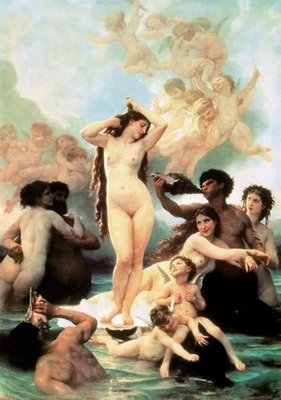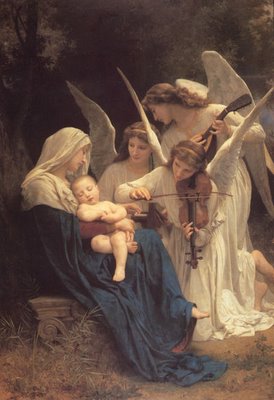
“It’s like abortion. You are either for or against it. The same can be said about this controversial artist.”
With these shocking words, Scott Schaefer, the paintings curator of the J.Paul Getty Museum summarized a circus-like two-hour lecture called “The Great Bouguereau Debate” held on Tuesday June 6th. A near-rabid crowd of a few hundred art-lovers and art-makers crammed into the luxurious Harold M. Williams Auditorium at the citadel-like Getty Center in Los Angeles to gnash their teeth or throw roses at the evil arch-villain of academia, William Adolph Bouguereau.
Say “Boo-grrrr-OH”
No other name in art-history has set off such emotion. The debate over the virtues of this dead painter goes far beyond whether one likes his work or not. Stating your opinion about his sensual nymphs or sweetly posed prepubescent peasants is like loudly stating your political-alignment. Are you from a red state or a blue state? It’s like proclaiming your bedroom preferences over a megaphone: Do you go for missionary style or experimentation? You must lean one way or another: Are you a sickly vegetarian or a blood-thirsty meat-eater? Intelligence level can also be deduced by your love of this controversial artist: Are you a misguided farmer or a hip Cosmopolitan? Choose!
From the evening’s onset, the Great Debate promised to be juicy. While riding the tram up to the gleaming Getty museum, the supporters of Bouguereau whispered passionately about how repugnant Bouguereau-haters were, and Bouguereau-detractors loudly dismissed those who would dare to support such saccharine drivel.
Upon entering the bustling auditorium, we were confronted immediately by a seventy foot high projected image of one of Bouguereau’s salon paintings depicting two charming young girls with a basket of fruit. Guests either “ooohed and ahhhed” or emitted a cackle and sneered at the sight of it before finding a seat. A guest was overheard saying “It’s like a hostile wedding. Should we sit on the bride’s side or the groom’s side?” Keeping my eye open, I saw many well-known realist painters in the crowd; preening, posing, hob-nobing and furiously praising the painter amongst themselves. Around them sat the enemies of the French Academician, with their lips upturned in disdainful smirks.

The occasion for this debate was sparked by the Getty’s recent display of a Bouguereau masterpiece: The Virgin and the Angels. The huge painting, dating from late ninteenth century France, belongs to the Forest Lawn mortuary in Glendale California. It has been in their collection for decades, and until recently it was rather thoughtlessly hung twelve feet high and glumly displayed in a dimly lit "museum” at the mortuary. Covered with murky soot and old yellow varnish, the one room museum was a pilgrimage for all realist painters in the know. Every time I sat breathing in the smog on the crowded freeway below, I could always glance up towards the hill at the building which housed this amazing canvas, and I took solace in knowing that “At least there is a beautiful artwork up there…”
Recently the Mortuary agreed to allow the Getty to display the Bouguereau in their world class gallery in exchange free cleaning and restoring. I visited the sparklingly clean painting recently, and wow! It is gorgeous. It glows and invites the viewer to explore every detail. In the finely realized composition life size angels hover intimately around the sleeping virgin Mary, who sits with a handsome snoozing baby Jesus in her lap. The angels play delicately on musical instruments, treating the mother and child with heavenly melodies. Very cool…
Or is it? The debate was to answer the burning question: Is this all just sappy, corny kitsch? In art history, after all, many teachers declare that despite his flawless technique William Adolph Bouguereau was (and is) nothing less than the world’s worst painter.
The lights dimmed and curator Scott Schaefer began by introducing the panelists for the night: historian Gerald Ackerman, artist Peter Zokosky, and Patrice Marandel, chief curator of European art at the Los Angeles County Museum of Art. The venerable Gerald Ackerman quietly began, telling us all how good the painter was by showing close up details of his paintings, his figure’s expressions and sentimentality made more poignant by the reminder that Bouguereau had lost a four-year-old child to Cholera, and his wife to fever. In other words, he knew deep emotion, and was not simply play-acting when he painted a mourning figure draped over the lap of a Virgin of mercy. Ackerman is a lover of all things smooth and classical, so no earth-shattering revelations sprang from his lips, (the exception being when he pointed out that, in The Virgin and the Angels, One ethereal being's violin bridge and bow form a perfect cross, hinting at the sleeping baby’s impending sacrifice and glorious death by crucifixion).
Artist Peter Zokosky was next, presenting as a pro-Bouguereau speaker. He was humorous and brief, primarily stating the points people make against the painter: Too Sentimental, Too Skilled, Too Popular, among other charges. In each case, he brushed the allegations away. “We demand skill from our barbers. Why not from our painters?” he asked the crowd, who applauded wildly. He was followed by the evening’s definite anti-Bouguereau panelist, Patrice Marandel, chief curator of European art, at the Los Angeles County Museum of Art. After a few disarming jokes, the mood in the auditorium was about to get heavy.
As if playing the role of Lord Darth Vader, Monseiur Marandel launched into a brutal attack against All things Bouguereau: His droll design, his lack of emotion, his lack of risk-taking, his sweet subject-matter, his slick technique, his inflated sales, his “unsophisticated” American patrons, and the questionable motives of his supporters were all topics. Marandel went so far as to imply that the artist’s sexual morals were in question by highlighting the number of naked young children found lounging around in his canvases. Dirt! Scandal! The crowd reeled from the assault, and reached a point of convulsion when Marandel aligned Bouguereau with “another painter you all know, one who panders to the approval of an uneducated public:” up on the wall sprang an eighty foot high slide of a Thomas Kinkade Cottage painting, windows all aglow with comforting light.
“I have just brought Thomas Kinkade to the J. Paul Getty!” crowed the crazed curator, with his arms raised in mock triumph. The crowd collectively screamed and averted their eyes.
Things got serious though when the microphones were opened to the audience. The first question for Marandel was direct: “Where is the Bouguereau that belongs to the Los Angeles County museum of art?” LACMA owns a small but beautiful example of the painter’s work called A Girl Reading. It is exquisite. No better example of late nineteenth century salon art exists within the museum’s collection, and as of late, it has been conspicuously…absent. Marandel stammered a bit. “Well, it doesn’t really go with the rest of the museum. I’ve tried it on this wall,Iv’e tried it on that wall. I finally put it in the American wing, since most of the buyers of his work were Americans. I tried hanging it above a horrible American piece of furniture, and it was o.k.” When pressed further, he admitted that he didn’t really like the painting, so it was now stuck in the museum’s basement. For this flippant comment, he was jeered by members of the now disillusioned crowd. I even “booed”. How one man in such a responsible position could deny art history that way was eerily disconcerting. I always suspected that the little painting was banished due to an individual’s personal taste.
Jeffrey Morseburg from Morseburg Gallery was sitting below me a row or two away. His head was turning bright red. Once he was able to flag down a microphone, he asked why frothy French painters like Boucher and Fragonard were allowed in the Museum, while a frothy Bouguereau was not. The Los Angeles County Curator shot back that Mr.Morseburg was wrong: “Bouguereau is not at all frothy, but rather dry.”
Make no mistake, the grand quibble over this painter was pointing to a greater elephant in the room. As Mr. Ackerman pointed out, “Bouguereau was a product of his own unique time, and it would be absurd to judge him by today’s standards. He and his work belonged authentically to a certain time and place which is now removed from our comprehension.” With so many twenty three year old academic art students currently worshipping Bouguereau and trying to emulate his style and surface finish, I wonder if they heard a single word when confronted by the question “Why would twenty first century realist painters not collectively paint for our fixed time and place as well?”
Everyone was confronted that evening with issues of academic fear and prejudice. In the end, Bouguereau challenges us as painters because we must ask: “Is the motive of artists to impress each other with technique? Is technique (or lack of technique) going to empower or silence me?” And the most blood-curdling question of all: Should I be a caboose, trailing after a faraway locomotive? Or should I dare to be a steam-engine, leading the way?” I hope that, as the audience went out to discuss the lecture at coffee shops around Los Angeles afterwards, the kool-aid drinkers of all persuasions dared to ask these most personal questions of themselves. In the end, Bouguereau was a hell of a painter. Bouguereau is dead. It is now our time to paint.
